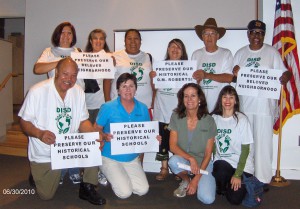DISD Buildings Top Preservation Group’s Most Endangered List
Vickery Wholesale Employees at Women's Museum at Fair Park in Dallas where Preservation Dallas announced it's 2010 most endangered list.
Thursday, July 1, 2010 Aging DISD buildings topped Preservation Dallas' newest "most endangered" list announced Wednesday, with the group wading into recent controversies over the fate of old schools in Oak Cliff and East Dallas.
This year's list, unveiled at a news conference in Fair Park, is broader than most in the past – consisting of categories such as "Dallas Public Libraries" or "South Dallas Historic Districts" alongside individual properties. It includes perennial items such as the Crozier Tech and Statler Hilton buildings downtown.
Wednesday's announcement of the group's fifth list is meant to highlight potential dangers to preservation efforts in Dallas. And the list generated at least one controversy – the owner of one property said it wasn't endangered at all.
The property – the Hickory Street Annex, a collection of 1920s-era buildings that were once a Gulf Oil distribution center – has been redeveloped into commercial and event venues.
The Preservation Dallas list explained that Hickory Street Annex fell within a planned extension of Interstate 30, for which "the majority of the property will be demolished." But Gary Kaelson, owner of the annex, said only two of the complex's seven buildings were potentially affected and that he thinks minor tweaks the expansion plans would save them. "I don't think we should be on that list," he said.
Preservation Dallas director Katherine Seale said representatives of the Hickory Street Annex had applied for inclusion on the most endangered list. But Kaelson said the application was submitted for designation as the organization's "Building of the Year."
Seale said the organization was keeping the Hickory Street Annex on its most endangered list but amended an accompanying statement to note that the complex was not in immediate danger.
Wednesday's announcement was attended by residents of Jubilee Park, who said they were there to support efforts to save Oran M. Roberts Elementary School.
DISD officials plan to raze the school building and build a replacement nearby. Norma Hernandez, a Roberts supporter, said her group opposed plans to tear down the school, even though it would be replaced with a $22 million facility. "The school has a lot of character and a lot of memories, and we do not think it ought to be torn down," she said.
The Roberts building was one of several the preservationist group said was threatened by DISD plans to replace aging facilities. The list also included Adamson High School and the Oak Cliff Christian Church building.
School officials want to demolish both buildings, putting a new campus on the church's former location.
Seale called on DISD officials to better communicate with parents and neighbors and suggested that the district sell the structures for redevelopment rather than demolish them.
A DISD spokesman declined to comment, noting that officials who could speak to the subject were on break until mid-July.













